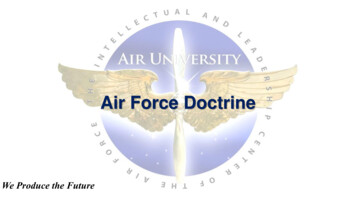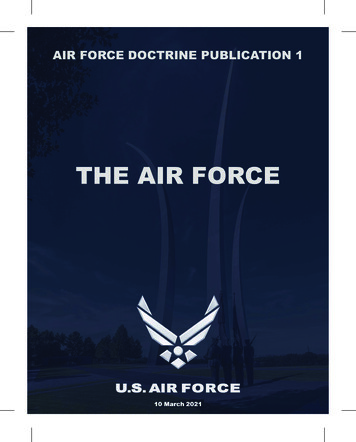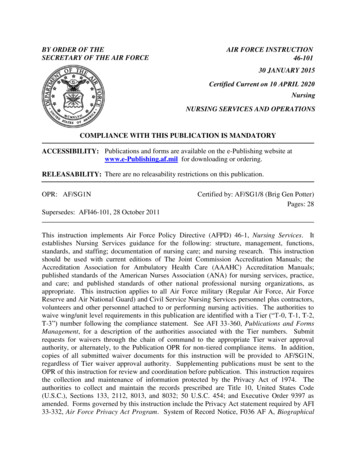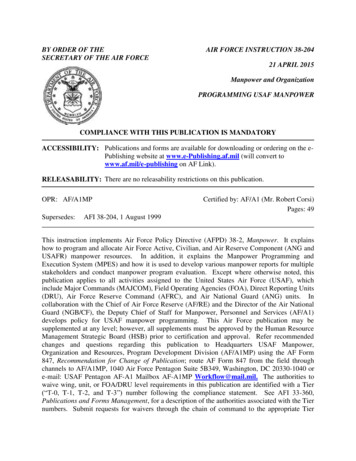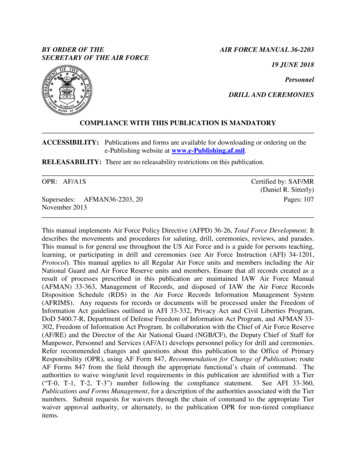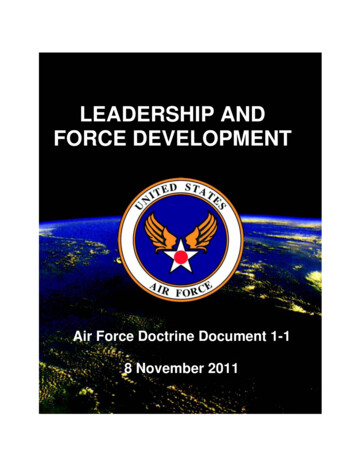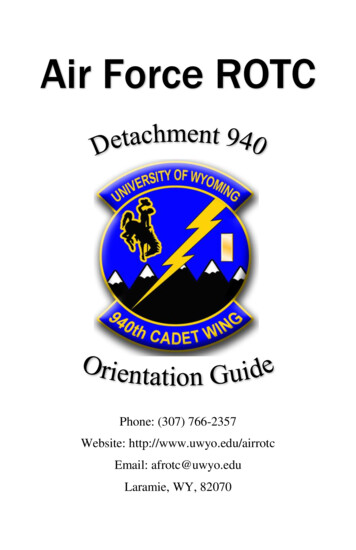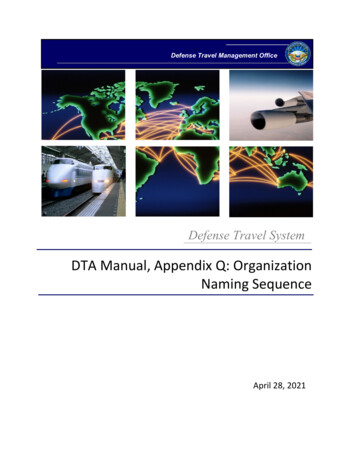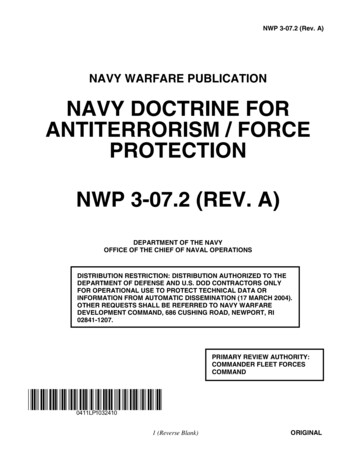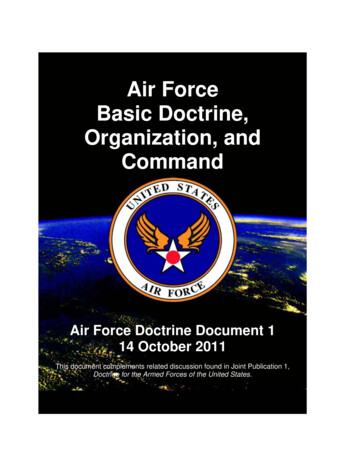
Transcription
Air ForceBasic Doctrine,Organization, andCommandAir Force Doctrine Document 114 October 2011This document complements related discussion found in Joint Publication 1,Doctrine for the Armed Forces of the United States.
BY ORDER OF THESECRETARY OF THE AIR FORCEAIR FORCE DOCTRINE DOCUMENT 114 OCTOBER 2011SUMMARY OF CHANGESThis revision not only updates and expands material from the previous version ofAir Force Doctrine Document (AFDD) 1, but also incorporates much material fromAFDD 2, Operations and Organization, due to a restructure of the doctrine documentpublication framework. As a result, this publication has been significantly restructuredand renamed Air Force Basic Doctrine, Organization, and Command. The Preface isnew to all AFDDs. The material presented in Chapter 1, Doctrine, has been revamped.Chapter 2, Airpower, is completely new and introduces new discussion on airpower andthe Airman’s perspective. Chapter 3, War, substantially updates previous discussion,and introduces irregular warfare and the role of culture in war. Chapter 4, Principlesand Tenets, is largely unchanged except for the inclusion of four additional principles ofoperations previously found in AFDD 2. This chapter also contains a truncateddiscussion on the range of military operations previously found in AFDD 2. Chapter 5,Air Force Functions, has been completely rewritten; the previous seventeen OperationalFunctions have been replaced by twelve new core functions. Most of the material inChapter 6, Commanding and Organizing Air Force Forces, was pulled forward fromAFDD 2; discussion has been appropriately updated. New material includes expandeddiscussion of air expeditionary task force organization, and integration of cyberspaceand nuclear capabilities. Homeland organizational discussion has been expanded.Chapter 7, The Air Force Component within the Joint Force, was largely pulled forwardfrom AFDD 2 and updated appropriately; new material consists of discussion onpresenting forces at different levels within a theater. Appendix A now presentsdiscussion on command authorities previously presented in the main text of AFDD 1.Appendices B and C were previously separate chapters in AFDD 2; the material wasmoved into appendices to aid the flow of discussion in the main text and the bulk ofmaterial was reduced. Appendix D contains updated discussion on the Air ReserveComponents. Finally, historical references have been updated throughout for currencyof discussion.Supersedes: AFDD 1, 17 November 2003OPR: LeMay Center/DDSCertified by: LeMay Center/CC (Maj Gen Thomas K. Andersen)Pages: 144Accessibility: Publications are available on the e-publishing website at www.e-publishing.af.mil fordownloadingReleasability: There are no releasability restrictions on this publicationApproved by: Norton A. Schwartz, General, USAFChief of Staff
FOREWORDThis document is the Air Force’s premier statement of warfighting principles andbeliefs. It is the senior doctrine publication from which all other Air Force doctrine flows.Historically, airpower has been associated with its more familiar and visibleaspects, such as air-to-air combat, strategic bombing, and long-range heavy airlift.However, airpower has many less visible but equally important missions across therange of military operations: providing close air support and tactical mobility to ourground forces; positioning and resupplying remote forces; obtaining and providingdetailed and timely intelligence, surveillance and reconnaissance; providinghumanitarian relief; projecting world-wide command and control; and training of coalitionpartners in the use of airpower, just to name a few. Also, while many parts of the AirForce are visibly engaged in overseas expeditionary operations, other aspects of the AirForce are quietly at work day-to-day, overwatching the homeland. These includenuclear forces on alert; ground- and space-based national warning systems;cyberspace forces monitoring the security of military networks; and fighters on call todefend sovereign airspace.Much has transpired in the world since the previous edition of AFDD 1 waspublished in 2003. Irregular warfare and homeland defense have taken on moreimportance; the Air Force has recognized cyberspace as an operational domain andhas renewed its commitment to nuclear operations; and we are now investing heavily inunmanned aircraft systems. Seven years ago, we could not have accurately foreseenthese changes; looking forward, the future is equally unpredictable. While we cannotaccurately predict where and how we’ll next be engaged, doctrine provides a leg up,outlining the basics of organization and command, providing guidance on how to thinkabout and plan for different types of operations and missions. These foundationalbasics allow us to respond more quickly, freeing commanders and planners to thinkabout larger issues such as strategy, operational art, and objectives.The success of our Air Force in meeting the challenges of this rapidly changingworld depends on understanding our doctrine. I encourage you to read it, discuss it,and apply it.NORTON A. SCHWARTZGeneral, USAFChief of Staff
TABLE OF CONTENTSPREFACE . viiCHAPTER ONE—Doctrine . 1Doctrine Defined . 1Policy, Strategy, and Doctrine . 3Uses of Doctrine . 4Sources of Doctrine . 6Levels of Doctrine . 8Types of Doctrine . 9Doctrine, Operating Concepts, and Vision . 9CHAPTER TWO—Airpower . 11Airpower . 11The Foundations of Airpower. 13’Airmindedness’ . 18The Airman’s Perspective . 19CHAPTER THREE—War . 21The Nature of War . 22Traditional and Irregular War . 23Culture and War . 24Levels of War. 25The Range of Military Operations . 26CHAPTER FOUR—Principles and Tenets . 29Principles of Joint Operations . 29Principles of War . 29Unity of Command . 30Objective . 30Offensive . 31Mass . 32Maneuver . 33Economy of Force . 33Security . 34Surprise . 35Simplicity . 35Additional Principles of Operations . 35Unity of Effort . 36Restraint . 36Perseverance . 36Legitimacy . 37Tenets of Airpower . 37Centralized Control and Decentralized Execution . 38Flexibility and Versatility . 39Synergistic Effects. 40Persistence . 40iv
Concentration . 41Priority . 41Balance . 41CHAPTER FIVE—Air Force Functions. 42Roles . 42Missions. 42Functions . 43Core Functions . 43Nuclear Deterrence Operations. 43Air Superiority. 45Space Superiority . 45Cyberspace Superiority . 46Command and Control . 47Global Integrated Intelligence, Surveillance, and Reconnaissance . 48Global Precision Attack . 48Special Operations . 49Rapid Global Mobility . 50Personnel Recovery . 51Agile Combat Support . 52Building Partnerships . 53CHAPTER SIX—Commanding and Organizing Air Force Forces . 54The Commander, Air Force Forces . 55Operational Responsibilities of the COMAFFOR . 56Service Responsibilities of the COMAFFOR . 57The Air Expeditionary Force . 58The Air Expeditionary Task Force (AETF) . 59Regional Organization and Control . 62Functional Organization and Control . 63AETF Organization . 63Numbered Expeditionary Air Force . 63Air Expeditionary Task Force-X. 64Air Expeditionary Wing . 64Air Expeditionary Group . 64Air Expeditionary Squadron . 65Expeditionary Elements below Squadron Level . 65Provisional Units . 67Designation of Expeditionary Units . 67Examples of AETFs . 68Command and Control Mechanisms . 69Air Operations Center (AOC) . 70AFFOR Staff. 71Distributed/Split Operations . 72Command Relationship Models for Air Force Forces . 73In-Theater Forces. 74Out-of-Theater Forces. 74Functional Forces. 75v
Transient Forces . 75Forces in Exercises . 76Transfer of Functional Forces to a Geographic Command . 76Integrating Regional and Functional Air Force Forces. 78Integrating Air Mobility Operations . 78Integrating Space Operations . 79Integrating Special Operations . 80Integrating Cyberspace Operations. 82Nuclear Support to Regional Commands . 83Integrating the Air Reserve Components . 83Homeland Organizational Considerations . 83The Senior/Host Air Force Installation Commander . 85CHAPTER SEVEN—The Air Force Component Within the Joint Force . 88Joint Force Organizational Basics . 88The Joint Force Air Component Commander . 90Control of Other Services’ Aviation Capabilities . 92Air Force Component Presentation Considerations. 94Levels of Force Presentation . 94Theater-Level Component . 95Sub-Theater-Level Component . 96Sub-Theater-Level AETF in Support of a JTF . 97Force Attachment Considerations . 97Achieving Unity of Effort . 98Joint Air Component Coordination Element . 99Air Component Relationships within a Joint Force . 100Theater Air Component Command Mechanism. 101Joint Liaisons in the AOC . 101Joint Staffs . 103Joint Staff Composition . 103Commanders and Staff . 103JFACC Staff . 103Multi-Hatting Commanders/Span of Command . 104Multinational and Interagency Integration . 104Multinational Operations . 104Interagency Coordination . 106CONCLUSION . 107APPENDIX A—Command Relationships and Authorities . 109APPENDIX B—The Air Operations Center . 114APPENDIX C—The AFFOR Staff . 117APPENDIX D—The Air Reserve Components . 121REFERENCES . 124GLOSSARY . 125vi
PREFACEAt the very heart of warfare lies doctrine. It representsthe central beliefs for waging war in order to achievevictory. Doctrine is of the mind, a network of faith andknowledge reinforced by experience which lays thepattern for the utilization of men, equipment, and tactics. Itis the building material for strategy. It is fundamental tosound judgment.— General Curtis E. LeMayAir Force Doctrine Document (AFDD) 1, Air Force Basic Doctrine, Organization,and Command, is the senior capstone document of Air Force doctrine. AFDD 1discusses the fundamental beliefs that underpin the application of Air Force capabilitiesacross the range of military operations. Its seven chapters range from the fundamentalsof airpower to discussion on commanding and organizing Air Force forces. AFDD 1provides guidance on the proper employment of airpower, sets the foundation foreducating Airmen on airpower, guides the development of all other AFDDs, andprovides insight where personal experience may be lacking.Much has transpired in the overall operational environment since the previousedition of AFDD 1 was published in 2003. The character of contemporary andimmediately foreseeable conflict has driven a significant shift in the US approach towarfighting. The large-scale, complex, force-on-force scenarios that drove much ofCold War planning, which were seen during Operation DESERT STORM and in theopening stages of Operation IRAQI FREEDOM, are now viewed as the exception,replaced by the complex and unpredictable pace of irregular war against nontraditionalenemies. Moreover, it appears that US engagement in such conflict may be ongoing forsome time.The Joint Operating Environment “provides a perspective on future trends,shocks, contexts, and implications” for the current and near-term security environment. 1Some of its key points are summarized as follows: The nature of the human condition guarantees that uncertainty, ambiguity, andsurprise will likely dominate the course of events. It is impossible to predict precisely how challenges may emerge and what form theymight take. The US may find itself caught off guard by changes in the political,economic, technological, strategic, and operational environments. The US will likelyfind itself surprised by the creativity and capability of its adversaries.1Joint Operating Environment 2010, US Joint Forces Command/J59.vii
Changes in the strategic landscape, the introduction and employment of newtechnologies, and the adaptation and creativity of our adversaries may alter thecharacter of joint operations. The causes of conflict will likely vary from rational political calculation to uncontrolledpassion. The enemy’s capabilities may range from explosive vests worn by suicidebombers to long-range precision-guided cyberspace, space, and missile attacks.The threat of mass destruction from nuclear, biological, and chemical weapons willlikely expand from stable nation-states to less stable states and even non-statenetworks. It is also conceivable that combinations of regional powers with sophisticatedregional capabilities could band together to form a powerful anti-US alliance. The great difficulty US forces confront in facing irregular warfare is that irregularconflicts require a thorough understanding of the cultural, religious, political, andhistorical context within which they are being fought, as well as substantialcommitments of “boots on the ground” for sustained periods of time. There are no“rapid decisive operations” in irregular warfare that can achieve swift victory. A defining element in military effectiveness lies in the ability to recognize whenprewar visions and understanding of war are flawed and must change.These changes have significant, long-term implications for the planning andconduct of US operations. Air Force studies of the likely future operating environment,such as the Air Force Strategic Environmental Assessment, make the following keypoints: The need for precision and detailed analysis has greatly expanded the scale ofinformation collection and processing; extensive networks are as important asbullets or bombs.Sensors, shooters, and fusion centers are routinelyinterconnected worldwide in a unified battle rhythm. The nature of irregular conflicts requires patient, long-term commitment to aconsistent, coherent strategic and political approach that integrates the diplomatic,informational, military, and economic elements of US, ally, and partner nation power.This requires renewed emphasis on, and long-term institutional commitment to,investment in building and sustaining effective partnerships that assures allies andfriends. The diffusion of lethal technologies in general and proliferation of weapons of massdestruction (WMD) creates new challenges to deterrence. The Cold War-era modelof deterring a small number of nuclear-armed states has been replaced by the needto develop a range of deterrence strategies against multiple potential adversaries,some of which are transnational non-state actors. Also, the proliferation of WMDmay make the US increasingly the subject of the deterrence operations of others. Inspite of these changes, nuclear deterrence will remain relevant; US nuclear forcesviii
will continue to play a critical role in deterring, and possibly countering, threats to ourvital interests. Threats against the US homeland could very well increase. The US should expectfuture opponents to launch both terrorist and unconventional attacks on the US andits territories. Civil, military, and industrial cyberspace networks have, for example,already seen an upswing in probes and intrusions. Despite the current low probability of conflict escalating to major combat operations,the US should retain the capability to execute conventional campaigns. Peer andnear-peer state actors will likely continue to challenge US access to the globalcommons. Non-state actors (and some state actors) will likely continue to seekasymmetric advantages. Their objectives may vary from regional hegemony tocultural and religious goals. Accordingly, the US should maintain the capability tosuccessfully project military power and maintain superiority in all domains. The proliferation of technology may allow adversaries to develop niche capabilitiesthat may threaten, in varying degrees, the successful conduct of operations in areaswhere US forces were previously unchallenged. Space and cyberspace networksare increasingly vulnerable to a wide array of new threats. Adversary anti-accesscapabilities will continue to improve, challenging our ability to project power andinfluence. The spread of increasingly effective surface-to-air defenses poses specialproblems for our Air Force.These changes and challenges have a ripple effect on doctrine. To beeffective—and most importantly, relevant—doctrine should adapt and evolve. The AirForce doctrine publication framework has transitioned to an A-staff framework, to betteralign Air Force doctrine documents conceptually with their joint counterparts, and torevise their content based upon the rethinking of our Service’s core functions. In theend, Air Force doctrine should provide a better, more relevant baseline for ongoing andfuture operations.Following the recent example of combining Joint Publication (JP) 1, Doctrine forthe Armed Forces of the United States, and JP 0-2, Unified Action Armed Forces, into asingle joint capstone document, this revision to AFDD 1 combines material from theprevious AFDD 1 and organizational discussion in the previous AFDD 2, Operationsand Organization, into a single Air Force capstone doctrine document.As previously mentioned, a great deal of the material in this document isunchanged from the material in the previous editions of AFDDs 1 and 2; this is to beexpected, if our foundational precepts are indeed enduring. Examples to supportdiscussion may have been updated to reflect recent experience.A note on terminology in Air Force doctrine: The Air Force prefers—and in fact,plans and trains—to employ in the joint fight through a commander, Air Forceforces (COMAFFOR) who is normally also dual-hatted as a joint force aircomponent commander (JFACC); when involved in multinational operations, theix
JFACC may become a combined force air component commander (CFACC). However,to simplify nomenclature in doctrine, Air Force doctrine documents simply use the term"COMAFFOR" with the assumption that, unless stated otherwise, the COMAFFOR isdual-hatted as the JFACC and perhaps CFACC. Air Force doctrine recognizes that thetwo responsibilities are different and should be executed through different staffs.Similarly, Air Force doctrine recognizes that the air operations center (AOC), in joint orcombined operations is correctly known as a joint AOC (JAOC) or combined AOC(CAOC). However, doctrine simply uses the term "AOC."Air Force doctrine is compatible with existing joint doctrine, but expands andelaborates upon it, because joint doctrine does not explicitly describe the philosophicalunderpinnings of any one Service, nor does it describe how a Service organizes tosupport a joint force commander. These are Service, not joint, prerogatives. The ideaspresented here should enable Airmen to better describe what the Air Force can provideto the joint effort. AFDD 1 should influence creation of corresponding joint and NorthAtlantic Treaty Organization doctrine, and may inform the doctrine of other Services aswell.The principal audience for this publication consists of all Airmen, both uniformedand civilian.x
CHAPTER ONEDOCTRINEThere is no end to the number of people who willline up to make flippant remarks that the doctrine istoo long, too short, has too many pictures, is tooacademic, is not academic enough . The acid testis do we read it, do we understand it, and do we useit, and DOES IT WORK? “al
Air Force Doctrine Document (AFDD) 1, but also incorporates much material from AFDD 2, Operations and Organization due to a restructure of the doctrine document , publication framework.

